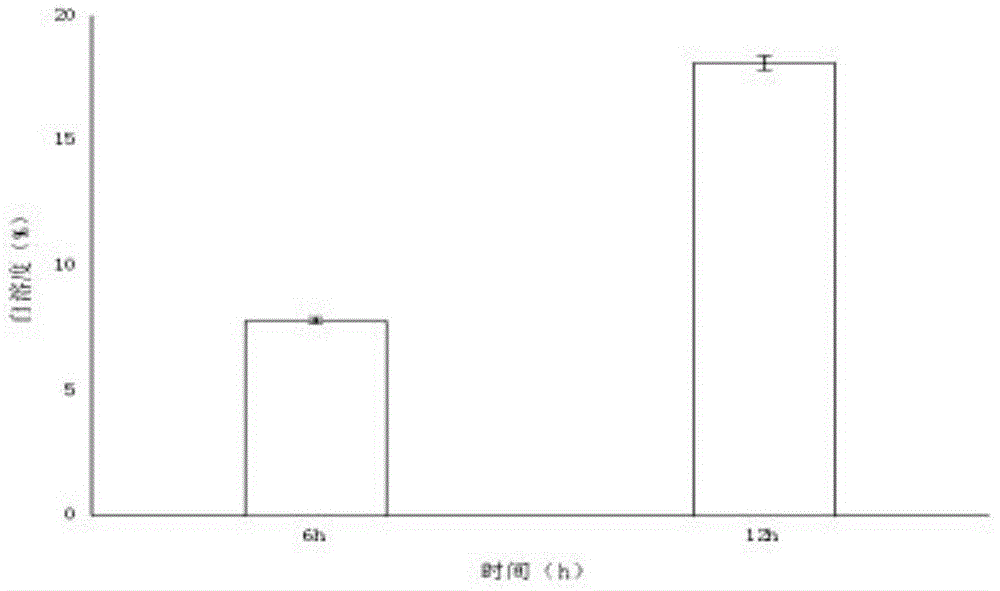Lactobacillus plantarum for highly producing ethyl caprate and application of lactobacillus plantarum
A technology of Lactobacillus plantarum and milk curd, which is applied in the field of microbiology, can solve problems such as unconsidered effects, achieve low cost, improve product sensory quality characteristics, and increase content
- Summary
- Abstract
- Description
- Claims
- Application Information
AI Technical Summary
Problems solved by technology
Method used
Image
Examples
Embodiment 1
[0023] Example 1 Camembert cheese without adding Lactobacillus plantarum CGMCC No.9739
[0024] The production process of Camembert cheese is as follows: the raw milk is pasteurized and then rapidly cooled to 32°C, adding a starter (Lactococcus lactis-MA 14 LYO, Danisco) and a mold starter (Penicillium kadisco-PC 12 LYO 20 D, Danisco and Geotrichum candidum-GEO17 LYO 2 D, Danisco), incubate at 32°C for 30-40 minutes, add 800 μg / g ethanol to the milk, add a certain amount of rennet for 45 minutes, and cut the clot After forming cube particles with a side length of 1 cm, keep warm at 32°C and then slowly stir after curing to remove the whey, and press and shape the curd cheese in the mold to further remove the whey. After the whey has been drained, the cheese is left to dry for a period of time to be brined. Then place it at a certain temperature for maturation.
[0025] Specific steps are as follows:
[0026] A) Pretreatment of raw milk: qualified standardized raw milk purch...
Embodiment 2
[0032] Embodiment 2 Add the Camembert cheese of plantaractobacillus CGMCC No.9739
[0033] 1. Preparation of Lactobacillus plantarum CGMCC No.9739 direct input working starter.
[0034] Lactobacillus plantarum CGMCC No.9739 was inoculated in MRS liquid medium with an inoculum of 1-3%, and cultured at 37°C for 20-24 hours, so that the number of viable Lactobacillus plantarum CGMCC No.9739 reached 10 8 cfu / mL or more, carry out centrifugation, centrifugation conditions: 4000rpm, 10min, 4°C, wash the precipitate twice with PBS buffer solution of pH 7.0, add lyoprotectant, adjust the cell concentration to 10 9 cfu / mL, after mixing evenly, carry out vacuum freeze-drying, and after freeze-drying, the described Lactobacillus plantarum CGMCC No.9739 direct-throwing working starter can be obtained.
[0035] 2. Production of Camembert cheese containing Lactobacillus plantarum CGMCC No.9739
[0036] The production process of Camembert cheese is as follows: the raw milk is pasteurized a...
Embodiment 3
[0059] Embodiment 3 uses Lactobacillus plantarum CGMCC No.9739 to prepare Swiss cheese
[0060] Cool the pasteurized milk to 35°C (maintain this temperature during the subsequent operation of cheese), add thermophilic starter and propionic acid bacteria starter, and after pre-acidification for a period of time, add Lactobacillus plantarum prepared as follows CGMCC No.9739 Subsidiary starter, stir evenly. Then add rennet to curd the milk. After the curd is completed, the cutting operation is carried out. After cutting, keep it warm for a period of time, and heat it up to 54°C by program while stirring for blanching treatment. After blanching for 45 minutes, milk discharge treatment is carried out. Put the whey-excluded curd into a mold for shaping and further whey-excluded operations. The working temperature is 50° C., the duration is 9 hours, and it is turned every 3 hours. The curd after milk draining is salted at a temperature of 7°C for 2 days. After the salting is compl...
PUM
 Login to View More
Login to View More Abstract
Description
Claims
Application Information
 Login to View More
Login to View More - R&D
- Intellectual Property
- Life Sciences
- Materials
- Tech Scout
- Unparalleled Data Quality
- Higher Quality Content
- 60% Fewer Hallucinations
Browse by: Latest US Patents, China's latest patents, Technical Efficacy Thesaurus, Application Domain, Technology Topic, Popular Technical Reports.
© 2025 PatSnap. All rights reserved.Legal|Privacy policy|Modern Slavery Act Transparency Statement|Sitemap|About US| Contact US: help@patsnap.com



